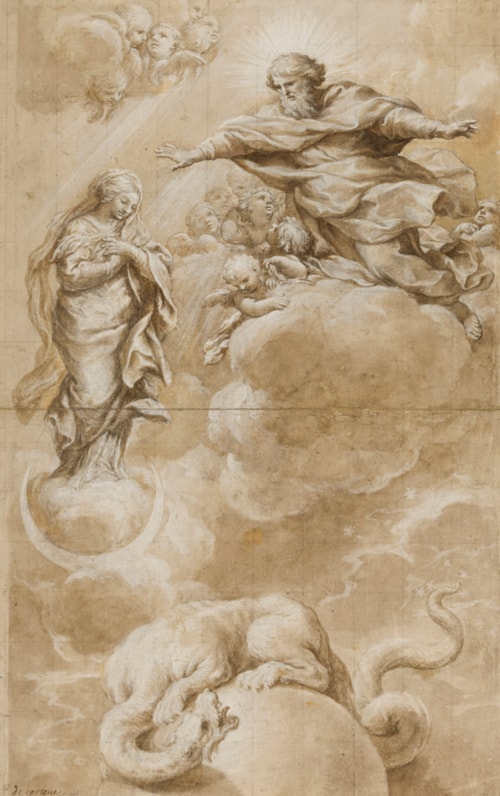
Ciro FERRI
Rome c.1634 - Rome 1689
Biography
The chief follower and assistant of Pietro da Cortona (1596-1669), Ciro Ferri entered his studio as an apprentice at the age of about sixteen. At this time Cortona was established as arguably the leading painter in Rome, having returned in 1647 from Florence, where he had decorated several rooms in the Palazzo Pitti. Ferri’s earliest major public commission was for part of the fresco decoration of the Gallery of Alexander VII at the Palazzo Quirinale, completed in 1656 under Cortona’s supervision. The following year he was admitted into the Accademia di San Luca, and painted lunette frescoes in a chapel in the church of San Marco. By this time he had come to fully assimilate Cortona’s style and had developed into one of the master’s most faithful pupils and assistants. As Lione Pascoli noted in his biography of the artist, ‘No other disciple than Ciro imitated so well the manner of his master Cortona: no one came close to his beautiful ideas, his bizarre inventions, more than he. None of them surpassed him in drawing…’ Working alongside Guglielmo Cortese, he decorated the Cesi chapel in the Roman church of Santa Prassede. Between 1659 and 1665 Ferri worked in Florence for the Grand Duke Ferdinando II de’Medici, completing the fresco decoration of the Sala di Apollo – which had been begun by Cortona – and the Sala di Saturno in the Palazzo Pitti, which may be regarded as among his most important works.
After some years spent working in Bergamo and Venice, Ferri returned to Rome for good following the death of his master in 1669. He completed several of Cortona’s unfinished projects, notably for mosaics at Saint Peter’s, while continuing to receive his own independent commissions. The most significant of these was for the fresco decoration of the cupola of the Roman church of Sant’Agnese in Agone, commissioned by the Pamphili family, which was begun in 1670 but was still unfinished at Ferri’s death nearly twenty years later. It was also around 1670 that he began to work occasionally as a sculptor, and to produce drawings for both sculptural and architectural projects. Pascoli wrote that Ferri ‘invento molti disegni per varie fabbriche e per vary altari’, and a number of designs for altars, reliquaries and tabernacles for churches in Rome and Florence, dating from the 1670s onward, are known; these include altars for the churches of Sant’Agnese, San Giovanni dei Fiorentini, San Nicola dei Tolentino and Santa Maria sopra Minerva in Rome, as well as the architecture and decoration of the choir chapel of Santa Maria Maddalena dei Pazzi in Florence, where he worked between 1675 and 1685. Much of Ferri’s later career was also occupied with providing designs for ornamental motifs in bronze or stucco, as well as for tapestries, mirrors, tabernacles, ceremonial carriages and, not least, over a hundred prints.
In his biography of the artist, Pascoli stated that Ferri preferred drawing to painting. His drawings were widely admired in his lifetime, and a number of them were reproduced as engravings. Yet his lifelong adherence to Cortona’s style has meant that drawings by the two have often been confused, and modern scholarship has only recently been able to differentiate between the draughtsmanship of master and pupil. Indeed, most extant drawings by Ferri have originally borne attributions to Cortona, which is true of the present sheet. More than three hundred drawings by Ferri have survived. The largest single collection of drawings by the artist, numbering over 140 sheets, is in the Istituto Centrale per la Grafica in Rome, while smaller groups are in the Museum Kunst Palast in Düsseldorf, the Uffizi in Florence and the Royal Collection at Windsor Castle.


